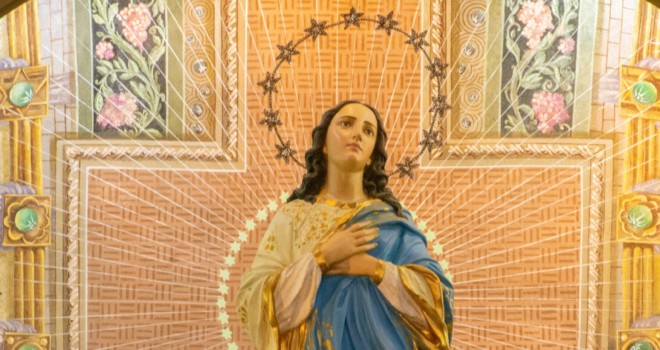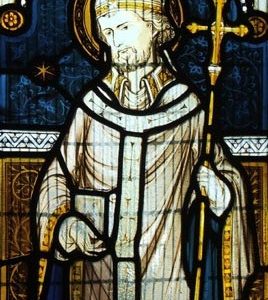“The Rosary is my favorite prayer. A marvelous prayer! Marvelous in its simplicity and its depth. In the prayer we repeat many times the words that the Virgin Mary heard from the Archangel, and from her kinswoman Elizabeth.”
“The Most Holy Virgin in these last times in which we live has given a new efficacy to the recitation of the Rosary to such an extent that there is no problem, no matter how difficult it is, whether temporal or above all spiritual, in the personal life of each one of us, of our families…that cannot be solved by the Rosary. There is no problem, I tell you, no matter how difficult it is, that we cannot resolve by the prayer of the Holy Rosary.”
One hundred seven years ago today, on May 6, 1913, Padre Pio wrote about his relationship with Mary to his spiritual director, Fr. Agostino:
“This most tender Mother in her great mercy, wisdom, and goodness, has punished me in a most exalted manner, by pouring so many great graces into my heart that when I am in her presence, or that of Jesus, I am compelled to exclaim, ‘Where am I? Who is near me?’ I am all aflame. I feel myself held fast and bound to the Son by means of His Mother.”
A few years later, a seer of Fatima, St. Jacinta, burst out in words quite similar, but further enflamed by her apostolic desires:
“If I could only put into the hearts of all the fire that is burning within my own heart, and that makes me love the Hearts of Jesus and Mary so very much!”
If we find our own relationship with the Blessed Mother not quite so ardent, there is an age-old remedy literally at our fingertips, ready to set us on fire with love, and solve our problems and pandemics to boot.
It is said of St. Padre
Pio, as well as of St. John Paul II, that the rosary was his favorite prayer.
When people asked how many rosaries he said a day, the answer varied but
numbered within the dozens. When people asked how he could manage this, St. Pio
replied, “How could I not?”
For most of us, eking out one rosary a day will be quite the accomplishment, but I don’t think the saints judge us harshly. St. Thérèse, for instance, wrote about her own experience, “When alone (I am ashamed to admit it) the recitation of the rosary is more difficult for me than the wearing of an instrument of penance.” Why not be little like her and, far from trying to pile up dozens of rosaries a day, strive for five decades each day this month — perhaps taking them one by one throughout the day? In this way we can join with the saints who are our contemporaries and respond to the recent request of our Holy Father who, only 10 days ago, wrote and asked us to do just this.
Pope Francis: Call Upon Mary
His Holiness Pope Francis, our sweet Christ on earth (as St. Catherine of Siena was inclined to call the Pope), has written to the Faithful a letter for the month of May 2020. Have you read it yet? It is perhaps his shortest letter to date:
Dear Brothers and Sisters,
The month of May is approaching, a time when the People of God express with particular intensity their love and devotion for the Blessed Virgin Mary. It is traditional in this month to pray the Rosary at home within the family. The restrictions of the pandemic have made us come to appreciate all the more this “family” aspect, also from a spiritual point of view.
For this reason, I want to encourage everyone to rediscover the beauty of praying the Rosary at home in the month of May. This can be done either as a group or individually; you can decide according to your own situations, making the most of both opportunities. The key to doing this is always simplicity, and it is easy also on the internet to find good models of prayers to follow.
I am also providing two prayers to Our Lady that you can recite at the end of the Rosary, and that I myself will pray in the month of May, in spiritual union with all of you. I include them with this letter so that they are available to everyone.
Dear brothers and sisters, contemplating the face of Christ with the heart of Mary our Mother will make us even more united as a spiritual family and will help us overcome this time of trial. I keep all of you in my prayers, especially those suffering most greatly, and I ask you, please, to pray for me. I thank you, and with great affection I send you my blessing.
The Holy Father includes two prayers he will say daily for us after his rosary. Incidentally, it was after praying the rosary in the presence of the St. John Paul II and seeing his fearless leader’s intense contemplative devotion that the future Pope Francis decided to recite the entire rosary — all the decades, not just five — every day from then on. How blessed we are to have in our trying times a successor to Peter who shares his predecessors’ love for the Mother of God!
The Pope’s first prayer ends with lines that are reminiscent of The Memorare, recently re-popularized by St. Mother Teresa in her emergency novena. In fact these lines are the traditional Sub Tuum Praesidium, considered one of the oldest prayers to Our Lady.
This lovely prayer is common to both Catholic and Orthodox believers, and used as a concluding prayer at Compline. In Pope Francis’ letter, it concludes the first prayer he invites us to say with him daily in this month of May, 2020:
O Mary,
You shine continuously on our journey
as a sign of salvation and hope.
We entrust ourselves to you, Health of the Sick,
who, at the foot of the cross,
were united with Jesus’ suffering,
and persevered in your faith.“Protectress of the Roman people,”
you know our needs,
and we know that you will provide,
so that, as at Cana in Galilee,
joy and celebration may return
after this time of trial.Help us, Mother of Divine Love,
to conform ourselves to the will of the Father
and to do what Jesus tells us.
For he took upon himself our suffering,
and burdened himself with our sorrows
to bring us, through the cross,
to the joy of the Resurrection.Amen.
We fly to your protection,
O Holy Mother of God;
Do not despise our petitions
in our necessities,
but deliver us always
from every danger,
O Glorious and Blessed Virgin.
The Holy Father’s second prayer is also lovely, but it is long. Read it, but let us answer that perennial question: “Why is May the month of Mary?”
Why is May Mary’s Month
As we approach the anniversary of Our Lady’s first appearance at Fatima on May 13, 1917, we have one answer. And yet May was Mary’s month long before she came to love us through the shepherd children.
A few years after Fatima, in 1921 the Vatican authorized the Feast of Our Lady of the Most Blessed Sacrament to be celebrated on May 13 each year by the Blessed Sacrament Congregations (they celebrate it to this day). Their founder, St. Peter Julian Eymard, the great apostle of the Eucharist, loved this name for Our Lady, and Pope St. Pius X said of it, “This title, Our Lady of the Blessed Sacrament, is perhaps the most meaningful of all.” And yet, again, May was Mary’s month long before.
On May 13 in 1883 (Pentecost that
year), Our Lady smiled upon the little girl Thérèse Martin, healing the one who
would become St. Thérèse of Lisieux. It was the anniversary, too, of her own
dear sister Céline’s first Holy Communion (in 1880), which Thérèse called “one
of the most beautiful days of my life.” And yet, again, we don’t quite have
here a definitive answer.
When demonstration, definition — and possibly even dialectic — elude us, the little ones often turn to poetry to reach the truth.
Canonized on the 13th of October just last year, good St. John Henry Cardinal Newman not only wrote poetry himself, but brought into the Church on October 21, 1866, Gerard Manley Hopkins, the Jesuit who gave us perhaps the best answer to our question in the form of one of the loveliest poems ever.
If you have trouble (as I have lately) saying your rosary in union with the Holy Father and the whole Church, perhaps this beautiful poem will help.
The May Magnificat
by Gerard Manley Hopkins
May is Mary’s month, and I
Muse at that and wonder why :
Her feasts follow reason,
Dated due to season—Candlemas, Lady Day ;
But the Lady Month, May,
Why fasten that upon her,
With a feasting in her honour?Is it only its being brighter
Than the most are must delight her?
Is it opportunist
And flowers finds soonest?Ask of her, the mighty mother :
Her reply puts this other
Question : What is Spring?—
Growth in every thing—Flesh and fleece, fur and feather,
Grass and greenworld all together ;
Star-eyed strawberry-breasted
Throstle above her nestedCluster of bugle blue eggs thin
Forms and warms the life within ;
And bird and blossom swell
In sod or sheath or shell.All things rising, all things sizing
Mary sees, sympathizing
With that world of good
Nature’s motherhood.Their magnifying of each its kind
With delight calls to mind
How she did in her stored
Magnify the Lord.Well but there was more than this :
Spring’s universal bliss
Much, had much to say
To offering Mary May.When drop-of-blood-and-foam-dapple
Bloom lights the orchard-apple
And thicket and thorp are merry
With silver-surfèd cherryAnd azuring-over greybell makes
Wood banks and brakes wash wet like lakes
And magic cuckoocall
Caps, clears, and clinches all—This ecstasy all through mothering earth
Tells Mary her mirth till Christ’s birth
To remember and exultation
In God who was her salvation.
✠
Photo by Murilo Santos on Unsplash












